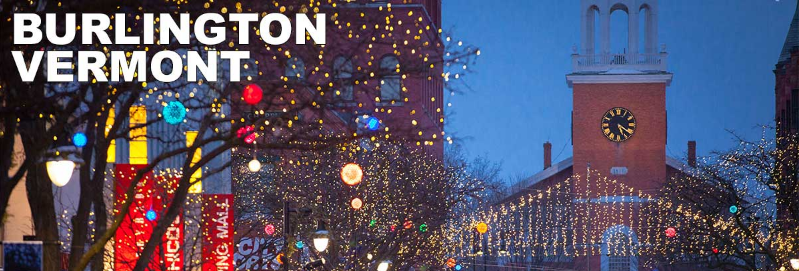Burlington, Vermont is unlike any other city in America. It built its economy not by recruiting big businesses from outside, but by growing local entrepreneurs. What’s more, it focused on green entrepreneurs.
Their main power plant burns wood, not fossil fuels, and rest of its energy comes from solar, wind, and small-scale hydro (it became America’s first 100% renewable energy city in 2015).
Burlington feeds itself from locally-grown food to a much greater degree than almost any other city. This, in a place with a short growing season. Lastly, it’s where Bernie Sanders‘ political career took off.
Burlington is the most populous city in Vermont, and the county seat of Chittenden County. It is located 45 miles (72 km) south of Canada. The population is about 43,000, making it the least populous city in the U.S. to be the most populous within a state. A regional college town, it’s home to the University of Vermont (UVM) and Champlain College.
Once a typically-depressed posts-industrial city, Burlington’s development office has pushed economic progress on multiple fronts. It helpedg establish a non-profit corporation that promoted energy savings in the city’s public and commercial buildings; bike paths along the previously inaccessible waterfront to reduce automobile use; curbside recycling pick-up well ahead of its time; and restoring buildings as business incubators.
“A lot of communities are ‘whale hunters,’ they think the answer is to business recruitment is to go after the big fish,” says Bruce Seifer of Burlington’s Community and Economic Development Office. “Instead we created a loan fund and helped local businesses and non-profits get started, places that would reinvest their time and effort locally, hire from within, serve on boards, and when times are tough not move out of state because they live here.”
Will Raap presides over 350 acres of reclaimed agricultural land that’s home to a dozen farms, from established growers to novice farmers taking advantage of low-rent farm “incubator” land. There’s the community gardens, a 600-member community-supported agriculture operation (the kind where you buy shares and get weekly boxes of harvested food in exchange), a nursery for growing riverfront buffer trees, and the Intervale Food Hub, where b oxes are loaded for delivery to people at their place of work or to 150 families identified by social service agencies as being in need.
Together they produce $1.3 million in foodstuffs for the Burlington market annually and provide 30,000 pounds of fresh food to families in need. “If we’re going to make the world a better place, if you can get food right, then you can get the environment and economic development and human health right,” says executive director Travis Marcotte. “Burlington would be very different if we hadn’t had this here, creating opportunity and familiarity with sustainable agriculture.”
Note from Storm: Bravo for Burlington! I went to college in Vermont, and spent an afternoon with Will Raap long ago, shortly after the wood-fired power plant went online. Burlington was also the location of one the the first professional talks I gave after my first book, The Restoration Economy, was published in 2002. This wonderful rebirth couldn’t have happened to a nicer city!

